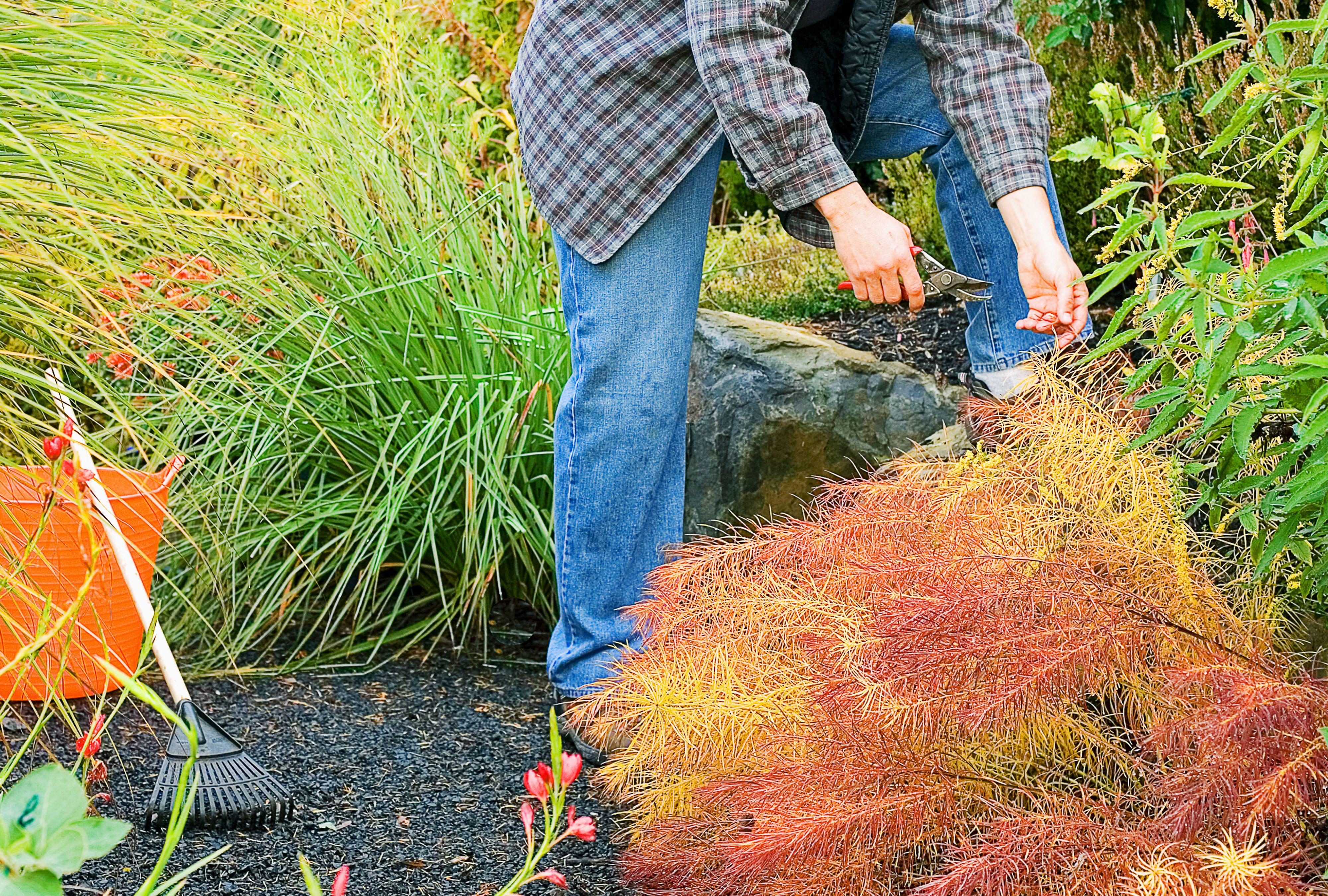Key Takeaways
- Except for diseased or pest-infected plants, don't cut back all your perennials in fall.
- Standing plants support wildlife, prevent snow drifts, and reduce urban flooding.
- Delay your yard cleanup until the spring, when soil temperatures stay above 50°F.
For this longest time, a thorough fall clean-up of planting beds was an integral part of the traditional garden routine to tidy up after the gardening season and prepare for spring. This approach not only creates more overall work for you, but it also has several environmental downsides. Leaving your plants standing is a big part of a more sustainable landscape in autumn and all year round.
Here are five reasons why you shouldn't automatically cut back all your ornamental plants in the fall and what to do instead.
Laurie Black
Related
Delaying your yard cleanup until spring offers numerous benefits for you and the surrounding ecosystem.
1. More Plants at No Cost
Letting beneficial plants self-seed and spread naturally creates a host of free plants. More plants mean less bare soil and fewer weeds, better retention of soil moisture, and reduced erosion—essentially improving soil health. If you cut down and clean up flower heads in the fall, you lose this no-cost seed source. It is still wise to deadhead overly aggressive plants to prevent them from self-seeding (and replacing those species might be a simpler long-term solution).
2. Supporting Wildlife
Seed-filled flower heads provide a natural food source for birds in winter, reducing the need for feeders. Plants that remain standing offer birds and other wildlife vital shelter from predators and harsh weather. Many native solitary bees use the hollow or pithy plant stems for shelter and nesting.
Don't worry about seeds from your plants attracting vermin. Rodents and other nuisance animals don't eat seeds; they prefer food waste in our trash.
3. Flood Control
In winter, plant stems and grasses help retain moisture, aiding in flood control. In areas prone to urban flooding, leaving plants standing slows down rain and snow runoff by absorbing moisture. Shrubs and trees contribute to this process too. The more plant material you have, the less water will rapidly run off impervious urban surfaces like pavement.
4. Natural Snow Fence
In addition to reducing water runoff, standing plants act as natural snow fences. They minimize snow drifting across sidewalks, roads, and driveways. The accumulation of snow around plants provides root insulation during frigid spells and helps rehydrate the soil as it melts in spring.
5. Winter Interest
The structural beauty of dried stems and seed heads adds architectural interest to the winter landscape. Embrace the rich hues of brown, black, copper, and umber for unique seasonal charm. Once you appreciate this new perspective, you might reconsider cutting back perennials and ornamental grasses.
Diseased or pest-contaminated plant material is an exception; it should be cut back in the fall and properly disposed of (not composted). This helps slow the spread of fungi, bacteria, viruses, and overwintering pests among your plants the following year.
When to Cut Back Your Ornamental Plants
So, when’s the right time to cut back perennials and ornamental grasses? Although some sources suggest waiting until daytime temperatures reach 50°F, it’s actually soil temperatures that matter. Microbial activity increases, and many overwintering insects and plants become active once soil temperatures consistently exceed 50°F.
In various regions, soil may warm enough by April, during fruit tree blooming, or when lawns need regular mowing. However, due to climate change and unpredictable weather patterns, it’s hard to identify the exact moment for spring garden cleanup.
Consider using a soil thermometer to determine when to start cutting back your plants. Many states provide soil temperature readings and maps to assist planting decisions. Consult your local land-grant university programs or the National Weather Service for guidance.
Susan Gilmore
How to Cut Back Perennials
In spring, when you’re ready to cut back perennials, use pruning shears to trim stems to the ground. Depending on the plant density and area, you might also use a string trimmer, hedge trimmer, or mulching mower. In some spots, you might not need to cut down plants at all, as winter snows can naturally flatten or break stems. Leaving old stems and fallen leaves in place acts as free mulch.
If you’re mulch-mowing a small backyard meadow where you want more self-seeding, consider raking and removing the cut material every couple of years. This allows more sunlight to reach the soil, aiding seed germination.
Plants to Always Leave Standing
The dry stems of certain native perennials offer excellent nesting habitats for around 25% of native bee species that utilize cavity nesting. Here are some plants that are especially beneficial for bees that are active from spring through midsummer:
- Coneflowers (Echinacea spp.)
- Golden Alexander (Zizia aurea)
- Ironweeds (Vernonia spp.)
- Milkweeds (Asclepias spp.)
- Rattlesnake master (Eryngium yuccifolium)
- Sweet Joe Pye weed (Eutrochium purpureum)
- Tall coreopsis (Coreopsis tripteris)
- Wild bergamot (Monarda fistulosa)
Leaving the stems of these plants 12 to 18 inches tall in spring ensures enough material for native bees to nest in. While this may look bare initially, new growth will quickly cover it.



